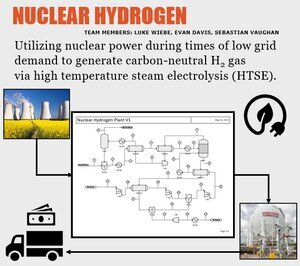
College of Engineering Unit:
In the United States and the rest of the developed world, the use of hydrogen is necessary by and for industries such as oil refining, ammonia production, and even steel production, with an approximated annual demand of 94 million metric tons. Current technologies constrain the production of this universally applicable industrial feedstock to energy intensive, carbon emitting processes such as steam reforming of methane, which unfortunately comes at the expense of consuming nonrenewable natural gas. High temperature steam electrolysis (HTSE) utilizes high temperature steam in conjunction with solid oxide electrolysis to achieve high throughput carbon-free hydrogen production, capable of meeting the worlds growing energy demands. However, the coupling of the HTSE process with next-generation nuclear reactors further reduces the independent energy demands the process has on the grid to achieve the desired transformations and would allow a hydrogen production facility to operate completely self-reliantly, meet production demands, and be able to more aptly produce said hydrogen while minimizing any straining effects a non-nuclear-powered plant might have on a nearby power grid when operated at times of low electrical demand.
| Attachment | Size |
|---|---|
| 627.38 KB |